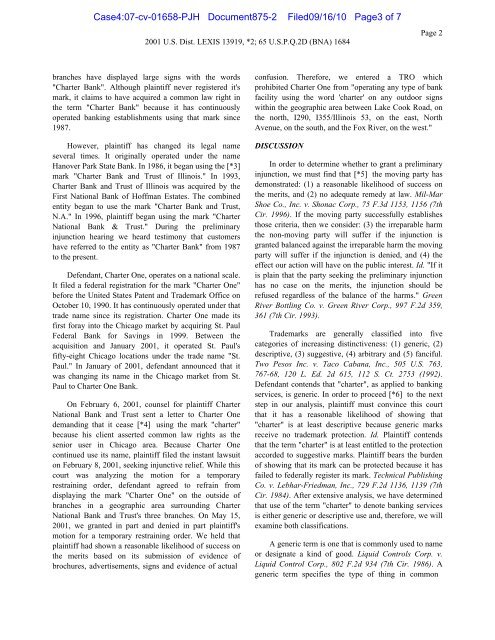exhibit 2 - SAP Lawsuit Portal
exhibit 2 - SAP Lawsuit Portal
exhibit 2 - SAP Lawsuit Portal
Create successful ePaper yourself
Turn your PDF publications into a flip-book with our unique Google optimized e-Paper software.
Case4:07-cv-01658-PJH Document875-2 Filed09/16/10 Page3 of 7<br />
2001 U.S. Dist. LEXIS 13919, *2; 65 U.S.P.Q.2D (BNA) 1684<br />
branches have displayed large signs with the words<br />
"Charter Bank". Although plaintiff never registered it's<br />
mark, it claims to have acquired a common law right in<br />
the term "Charter Bank" because it has continuously<br />
operated banking establishments using that mark since<br />
1987.<br />
However, plaintiff has changed its legal name<br />
several times. It originally operated under the name<br />
Hanover Park State Bank. In 1986, it began using the [*3]<br />
mark "Charter Bank and Trust of Illinois." In 1993,<br />
Charter Bank and Trust of Illinois was acquired by the<br />
First National Bank of Hoffman Estates. The combined<br />
entity began to use the mark "Charter Bank and Trust,<br />
N.A." In 1996, plaintiff began using the mark "Charter<br />
National Bank & Trust." During the preliminary<br />
injunction hearing we heard testimony that customers<br />
have referred to the entity as "Charter Bank" from 1987<br />
to the present.<br />
Defendant, Charter One, operates on a national scale.<br />
It filed a federal registration for the mark "Charter One"<br />
before the United States Patent and Trademark Office on<br />
October 10, 1990. It has continuously operated under that<br />
trade name since its registration. Charter One made its<br />
first foray into the Chicago market by acquiring St. Paul<br />
Federal Bank for Savings in 1999. Between the<br />
acquisition and January 2001, it operated St. Paul's<br />
fifty-eight Chicago locations under the trade name "St.<br />
Paul." In January of 2001, defendant announced that it<br />
was changing its name in the Chicago market from St.<br />
Paul to Charter One Bank.<br />
On February 6, 2001, counsel for plaintiff Charter<br />
National Bank and Trust sent a letter to Charter One<br />
demanding that it cease [*4] using the mark "charter"<br />
because his client asserted common law rights as the<br />
senior user in Chicago area. Because Charter One<br />
continued use its name, plaintiff filed the instant lawsuit<br />
on February 8, 2001, seeking injunctive relief. While this<br />
court was analyzing the motion for a temporary<br />
restraining order, defendant agreed to refrain from<br />
displaying the mark "Charter One" on the outside of<br />
branches in a geographic area surrounding Charter<br />
National Bank and Trust's three branches. On May 15,<br />
2001, we granted in part and denied in part plaintiff's<br />
motion for a temporary restraining order. We held that<br />
plaintiff had shown a reasonable likelihood of success on<br />
the merits based on its submission of evidence of<br />
brochures, advertisements, signs and evidence of actual<br />
confusion. Therefore, we entered a TRO which<br />
prohibited Charter One from "operating any type of bank<br />
facility using the word 'charter' on any outdoor signs<br />
within the geographic area between Lake Cook Road, on<br />
the north, I290, I355/Illinois 53, on the east, North<br />
Avenue, on the south, and the Fox River, on the west."<br />
DISCUSSION<br />
Page 2<br />
In order to determine whether to grant a preliminary<br />
injunction, we must find that [*5] the moving party has<br />
demonstrated: (1) a reasonable likelihood of success on<br />
the merits, and (2) no adequate remedy at law. Mil-Mar<br />
Shoe Co., Inc. v. Shonac Corp., 75 F.3d 1153, 1156 (7th<br />
Cir. 1996). If the moving party successfully establishes<br />
those criteria, then we consider: (3) the irreparable harm<br />
the non-moving party will suffer if the injunction is<br />
granted balanced against the irreparable harm the moving<br />
party will suffer if the injunction is denied, and (4) the<br />
effect our action will have on the public interest. Id. "If it<br />
is plain that the party seeking the preliminary injunction<br />
has no case on the merits, the injunction should be<br />
refused regardless of the balance of the harms." Green<br />
River Bottling Co. v. Green River Corp., 997 F.2d 359,<br />
361 (7th Cir. 1993).<br />
Trademarks are generally classified into five<br />
categories of increasing distinctiveness: (1) generic, (2)<br />
descriptive, (3) suggestive, (4) arbitrary and (5) fanciful.<br />
Two Pesos Inc. v. Taco Cabana, Inc., 505 U.S. 763,<br />
767-68, 120 L. Ed. 2d 615, 112 S. Ct. 2753 (1992).<br />
Defendant contends that "charter", as applied to banking<br />
services, is generic. In order to proceed [*6] to the next<br />
step in our analysis, plaintiff must convince this court<br />
that it has a reasonable likelihood of showing that<br />
"charter" is at least descriptive because generic marks<br />
receive no trademark protection. Id. Plaintiff contends<br />
that the term "charter" is at least entitled to the protection<br />
accorded to suggestive marks. Plaintiff bears the burden<br />
of showing that its mark can be protected because it has<br />
failed to federally register its mark. Technical Publishing<br />
Co. v. Lebhar-Friedman, Inc., 729 F.2d 1136, 1139 (7th<br />
Cir. 1984). After extensive analysis, we have determined<br />
that use of the term "charter" to denote banking services<br />
is either generic or descriptive use and, therefore, we will<br />
examine both classifications.<br />
A generic term is one that is commonly used to name<br />
or designate a kind of good. Liquid Controls Corp. v.<br />
Liquid Control Corp., 802 F.2d 934 (7th Cir. 1986). A<br />
generic term specifies the type of thing in common


